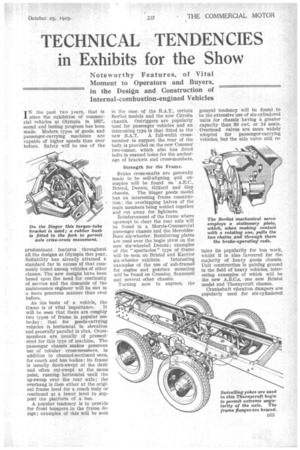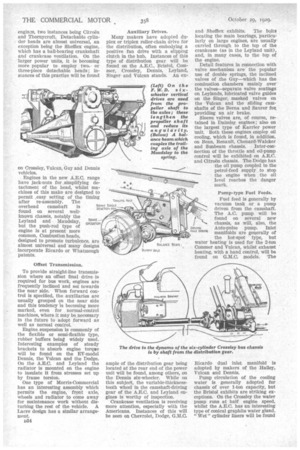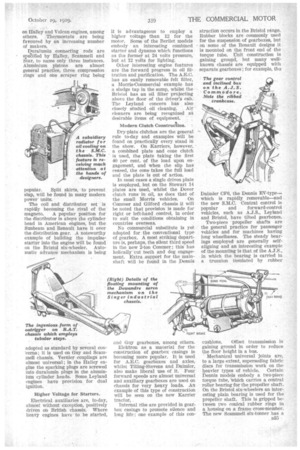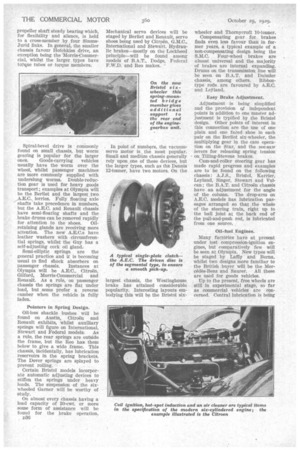TECHNICAL TENDENCIES in Exhibits for the Show
Page 99

Page 100

Page 101

Page 102

Page 103

If you've noticed an error in this article please click here to report it so we can fix it.
Noteworthy Features, of Vital Moment to Operators and Buyers, in the Design and Construction of Internal-combustion-engined Vehicles
IN the past two years, that is since the exhibition of commercial vehicles at Olympia in 1927, sound and lasting progress has been made. Modern types of goods and• passenger-carrying machines are capable of higher speeds than ever before. Safety will be one of the
predominant features throughout all the designs at Olympia this year. Reliability has already attained a standard far in excess of that commonly found among vehicles of other classes. The new designs have been based upon the need for continuity of service and the demands of the maintenance engineer will be met in a more generous manner than ever before, . As the basis of a vehicle, the frame is of vital importance. It will be seen that there are roughly two types of frame in popular use to-day ; that for goods-carrying vehicles is horizontal in elevation and generally parallel in plan. Crossmembers are usually of pressedsteel for this type of machine. The passenger chassis makes generous use of tubular cross-members, in addition to channel-sectioned ones, for coach and bus bodies ; its frame is usually down-swept at the dash and often out-swept at the same point, running horizontal until the up-sweep over the rear axle; the overhang is then either at the original frame level for a coach body or continued at a lower level to support the platform of a bus.
A popular tendency is to provide for front bumpers in the frame design ; examples of This will be seen in the case of the B.A.T., certain Berllet models and the new Citreen chassis. Outriggers are , popularly used for passenger vehicles and an interesting-type is that fitted to the
new B.A.T. A full-width crossmember to support the rear of the body is provided on the new Commer two-tonner, which also has fitted bolts in reamed holes for the anchorage of brackets and cross-members.
Strength for the Frame.
Brake cross-shafts are generally made to be self-aligning and examples will be found on A.E.C., Bristol, Dennis, Gifford and Guy chassis. The Singer goods model has an interesting frame constrdclion ; the overlapping halves of the main members being welded together and cut away for lightness.
Reinforcement of the frame where up-swept to clear the rear axle will be found in a Morris-Commercial passenger chassis and the MercedesBenz six-wheeler. Reinforcing plates are used over the bogie pivot on the new six-wheeled Dennis ; examples of the " spectacles" type of frame will be seen on Bristol and Karrier six-wheeler exhibits. Interesting examples of the use of sub-frame4 for engine and gearbox mounting will be found on Crossley, Scanamell and several other chassis.
Turning now to engines, the general tendency will be found to be the extensive use of six-cylindered units for chassis having a greater capacity than 30 cwt. or 14 seats. Overhead valves are more widely adopted for passenger-carrying vehicles, but the side valve still re tains its popularity for bus work, whilst it is also favoured for the majority of heavy goods chassis. Unit construction is gaining ground in the field of heavy vehicles, interesting examples of which will be the new A.E.C.s, one new Bristol model and Thornycroft chassis.
Crankshaft vibration dampers are popularly used for six-cylindered engin3s, two instances being Citroen and Thornycroft. Detachable cylinder heads are almost universal, an exception being the Shefllex engine, which has a ball-bearing crankshaft and crankcase ventilation. On the larger power units, it is becoming more popular to employ twoor three-piece detachable heads; instances of this practice will be found on Crossley, Vulcan, Guy and Dennis vehicles, Engines in the new A.E.C. range have jack-nuts for simplifying detachment of the head, whilst machines of this make are designed to permit easy setting of the timing , after re-assembly. The •DA.keptc Au
overhead camshaft is BRAKE TOPOUE
found on several wellu known chassis, notably the Leyland and Maudslay, but the push-rod type of engine is at present more common. Combustion heads, designed to promote turbulence, are almost universal and many designs incorporate Ricardo or Whatmough patents.
(PERATIGN
Offset Transmission.
To provide straight-line transmission where an offset final drive is required for bus work, engines are frequently inclined and set towards the near side. When forward control is specified, the auxiliaries are usually grouped on the near side and this tendency is becoming more marked, even for normal-control machines, where it may be necessary in the future to adopt forward as well as normal control.
Engine suspension is commonly of the flexible or semi-flexible type, rubber buffers being widely used. Interesting examples of steady brackets to absorb engine torque will be found on the EV-model Dennis, the Vulcan and the Dodge. On the A.E.C. and Leyland the radiator is mounted on the engine to insulate it from stresses set up by frame torsion.
One type of Morris-Commercial has an interesting assembly which permits the engine, front axle, wheels and radiator to come away for maintenance work without disturbing the rest of the vehicle. A Lam.° design has a similar arrangement.
n34 Auxiliary Drives.
Many makers have adopted duplex or triplex roller-chain drive for the distribution, often embodying a positive fan drive with a slipping clutch in the hub. Instances of this type of distribution gear will be found on the A.E.C., Bristol, Cornflier, Crossley, Dennis, Leyland, Singer and Vulcan stands. An ex ample of the distribution gear being located at the rear end of the power unit will be found, among others, on the Dennis six-wheeler. While on this subject, the variable-thicknesstooth wheel in the camshaft-driving gear of the A.E.C. and Leyland engines is worthy of inspection.
Crankcase ventilation is receiving more attention, especially with the Americans. Instances of this will be seen on Chevrolet, Dodge, G.M.C. and Shetilex exhibits. The bolts locating the main bearings, particularly on large engines, are usually carried through to the top of the crankcase (as in the Leyland unit), and, in many cases, to the top of the engine.
Detail features in connection with valve mechanism are the popular use of double springs, the inclined valves of the Guy—which has the combustion chambers mainly over the valves—separate valve seatings on Leylands, lubricated valve guides on the Singer, masked valves on the Vulcan and the sliding camshafts of the Bernet and San rer for providing an air brake.
Sleeve valves are, of course, retained in Daimler engines; also on the largest type of Karrier power unit. Both these engines employ oil cooling, which is found, in addition, on Bean, Renault, Chenard-Waleker
and Sunbeam chassis. Inter-connection of the throttle and oil-pump control will be exhibited on A.E.C. and Citroen chassis. The Dridge has the oil pump coupled to the petrol-feed supply to stop the engine when . the oil Ievel reaches the danger mark.
Pump-type Fuel Feeds.
Fuel feed is generally by vacuum tank or a pump driven from the camshaft. The A.C. pump will be found on several new chassis, as will, also, the
DRoANG Auto-pulse pump. Inlet
manifolds are generally of
the hot-spot type, but water heating is used for the 2-ton Commer and Vulcan, whilst exhaust heating, with a hand control, will be found on G.M.C. models. The
Ricardo dual inlet manifold Is adopted by makers of the Halley, Vulcan and Dennis.
Pump circulation of the cooling water is generally adopted for chassis of over 1-ton capacity, but the Bristol exhibits are striking exceptions. On the Crossley the water pump runs at half engine speed, whilst the A.E.C. has an interesting type of conical graphite water gland. " Wet " cylinder liners will be found on Halley and Vulcan engines, among others. .Thermostats are being favoured by an increasing number of makers.
Duralumin connecting rods are speCified by Halley, Scammell and Star, to name only three instances. Aluminium pistons are almost general practice, three compression rings and one scraper ring being popular. Split skirts, to prevent
slap, will be found in many modern power units.
The coil and distributor set is rapidly becoming the rival of the magneto. A popular position for the distributor is above the cylinder head in American engines, but the Sunbeam and Renault have it over the distribution gear. A noteworthy example of building the impulsestarter into the engine will be found on the Bristol six-wheeler. Automatic advance mechanism is being
adopted as standard by several concerns; it is used on Guy and ScammeLl chassis. Vernier couplings are almost universal ; in the Halley engine the sparking plugs are screwed into duralumin plugs in the aluminium cylinder heads. Some Leyland engines have provision tor dual Higher Voltage for Starters.
Electrical auxiliaries are, to-day, almost without exception, positively driven on British chassis. Where heavy engines have to be started, it is advantageous to employ a higher voltage than 12 for the motor. Some of the Berliet models embody an interesting combined starter and dynamo which functions as the former at 24 volts pressure, but at 12 volts for lighting.
Other interesting engine features are the forward progress in oil filtration and purification. The A.E.C. has an easily removable felt filter, a Morris-Commercial example has a sludge tap in the sump, whilst the Bristol has an oil filter projecting above the floor of the driver's cab. The Leyland concern has also closely studied oil cleaning. Air cleaners are being recognized as desirable items of equipment.
Modern Clutch Constructon.
Dry-plate clutches are the general rule to-day and examples will be found on practically every stand in the show. On "Carriers, however, a combined plate and cone clutch is used, the plate taking the first 40 per cent, of the load upon engagement, and when the slip has ceased, the cone takes the full load and the plate is out of action.
In most cases a single driven plate is employed, but on the Stewart 14 plates are used, whilst the Dover clutch runs in oil, as does that of the small Morris vehicles. On Commer and Gilford chassis it will be noted that provision is made for right or left-hand control, in order to suit the conditions obtaining in countries overseas.
No commercial substitute is yet adopted for the conventional type of gearbox. A most striking departure is, perhaps, the silent third speed in the new 2-ton Commer ; this has helically -cut teeth and dog engagement. Extra support for the mainshaft will be found in the Dennis
and Guy gearboxes, among others.
Elektron as a material for the construction of gearbox casings is becoming more popular. It is used for A.E.C. gearboxes and axles, whilst Tilling-Stevens and Daimler, also make liberal use of it. Four forward speeds are almost universal and auxiliary gearboxes are used on chassis for very heavy loads. An example of this type of construction will be seen on the new Karrier tractor, Internal ribs are provided in gearbox casings to promote silence and long life; one example of this con struction occurs in the Bristol range. Rubber blocks are commonly used for the suspension of gearboxes, but on some of the Renault designs it is mounted on the front end of the torque tube. Unit construction is gaining ground, but many wellknown chassis are equipped with separate gearboxes ; for example, the
Daimler CF, the Dennis By-type---which is rapidly removable—and the new S.M.C. Central control is popular and forward-control vehicles, such as A.J.S., Leyland and Bristol, have tilted gearboxes.
Two-piece propeller shafts are the general practice for passenger vehicles and for machines having long wheelbases. The steady bearings employed are generally selfaligning and an interesting example of the mounting is that of the A.J.S., in which the bearing is carried in a trunnion insulated by rubber cushions. Offset transmission is gaining ground in order to reduce the floor height in a bus.
' Mechanical universal 'joints are, to a large extent, superseding fabric discs for transmission work on the heavier types of vehicle. Certain Dennis models embody a two-piece torque tube, 'which carries a central roller bearing for the propeller shaft. On the Bristol six-wheelers an interesting plain bearing is used for the propeller shaft. This is gripped between two conical rubber rings in a housing on a frame cross-member. The new Scammell six-tonner has a
propeller shaft steady bearing which, for flexibility and silence, is held to a cross-member by four SimmsJurid links. In general, the smaller chassis favour Hotchkiss drive, an exception being the Morris-Commercial, whilst the larger types have torque tubes or torque members.
Spiral-bevel drive is commonly found on small chassis, but worm gearing is popular for the larger ones. Goods-carrying vehicles usually have the worm over the wheel, whilst passenger machines are more commonly supplied with underslung worms. Double-reduction gear is used for heavy goods transport ; examples at Olympia will be the Berliet and the largest two lorries. Fully floating axle shafts take precedence in numbers, but the A.E.C. and Renault chassis have semi-floating shafts and the brake drums can be removed rapidly
for, attention to the shoes. Oilretaining glands are receiving more attention. The new A.E.C.s have leather washers with circumferential springs, whilst the Guy has a self-adjusting cork oil gland.
Semi-elliptic springs are the general practice and it is becoming usual to find Shock absorbers on
passenger chassis. Instances at Olympia will be A.E.C.. Citroen, Gilford, Morris-Commercial and Renault. As a rule, on passenger chassis the springs are fiat under load, but some prefer a reverse camber when the vehicle is fully laden.
Pointers in Spring Design.
Oil-less shackle bushes will be found on Austin, Citroen and Renault exhibits, whilst auxiliary springs will figure on International, Stewart and Federal models: As a rule, the rear springs are outside the frame, but the Reo has them below to give a wide frame. This chassis, incidentally, has lubrication reservoirs in the spring brackets. The Dover springs are splayed to prevent rolling.'
Certain Bristol models incorporate automatic adjusting devices to stiffen the springs under heavy loads. The suspension of the six wheeled Garner will be worthy of study.
On almost every chassis having a lead capacity of 30-cwt. or more some form of assistance will be found for the brake operation.
D36 Mechanical servo devices will be staged by Berliet and Renault, servo shoes being used by Citroen, G.M.C., International and Stewart. Hydraulic brakes—mostly on the Lockheed principle—will be found among models of B.A.T., Dodge, Federal F.W.D. and Reo makes.
. In point of numbers, the vacuumservo motor is , the most popular. Small and medium chassis generally rely upon_ one of these devices, but the larger types, such as the Dennis 12-tonner, have two. motors. On the largest chassis, the Westinghouse brake has attained considerable popularity. Interesting layouts embodying this will be the Bristol six wheeler and Thornycroft 10-tonner.
Compensating gear for brakes finds even less favour, than in former years, a typical example of a non-compensating design being the S.M.C. Four-wheel brakes are almost universal and the majority of brakes are internal expanding. Drums on the transmission line will be seen on B.A.T. and Daimler chassis, among others. Ribbontype rods are favoured by A.E.C. and lalland.
Easy Brake Adjustment.
Adjustment is being simplified and the provision of independent points in addition to one master adjustment is typified by the Bristol design. Other points of interest in this connection are the use of one plain and one faced shoe in each pair on the Berliet six-wheeler, the multiplying gear in the cam operation on the Star, and the see-saw levers for releasing spring tension on Tilling-Stevens brakes.
Cam-and-roller steering gear has made rapid progress and examples are to be found on the following chassis : A.J.S., Bristol, Karrier, Leyland, Singer, Stewart and Vulcan; the BAT. and Citroen chassis have an adjustment for the angle of the column. The drop-arm on A.E.C. models has lubrication passages arranged so that the whole of the steering train, right up to the ball joint at the back end of the pull-and-push rod, is lubricated from one source.
Oil-fuel Engines.
Many factories have at present under test compression-ignition engines, but comparatively few will be seen at Olympia. New types will be staged by Lail:1y and Berna, whilst two designs more familiar to the British buyer will be the Mercedes-Benz and Saurer. All these are used for goods vehicles.
Up to the present, free wheels are still in experimental stage, so far as commercial vehicles are concerned. Central lubrication is being standardized by many makers, but grouped-nipple systems for gun lubrication are being widely adopted. Radiators with Still tubes will be seen on A.E.C.s and certain other chassis may be shown with this type of cooling apparatus.
A detail point is that radiators are being made very much deeper than before, particularly for passenger vellidesand the starting handle has to be brought through the tube block in consequence. Instances of
this practice will be seen on A.E.C., Commer and Halley stands. Ribbontype radiator shells will be used on some Commer and Dennis vehicles.
Amongst the six-wheelers, four of the notable newcomers are the Bristol designs, the Leyland and Dennis 12-tonners and Thornycroft 10
tonner. These are intended for road work, whilst the striking new Garner is fOr.croSs-country service. A.E.C., Bristol and Dennis make use
of three differentials; the only Instance of a rigid bogie will be that of the Trojan, whilst two-wheel drive on six-wheelers will be found in the 13erliet and Maudslay ranges.
There is a considerable difference of opinion regarding suspension. For example, the "Carrier and Thornycroft bogies have four semielliptic springs, whi1st the Mercedes 10-tonner and the Dennis I2-tonner have only two springs—in each casa inverted semi-elliptics.




























































































































































































